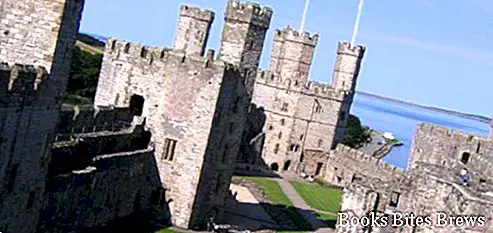What to see in Wales, itinerary including the main monuments and places of interest, including the capital Cardiff, natural parks and San David.
Tourist information
State of the United Kingdom, Wales is located on a peninsula extending into the Irish Sea in the south west of Great Britain.
To get to Cardiff, the capital of Wales, it takes about two hours from London, the language spoken is English, but it is Welsh at the base of the culture of the people, one of the oldest languages in Europe.
The landscape surprises for its natural beauty, from the mountains and moors, to open beaches and wild cliffs, delightful villages, monuments and castles that feed legendary stories.
Its territory is largely mountainous, crossed from north to south by the chain of the Cambrian mountains, whose highest elevation is represented by the Snowdon massif, 1085 m above sea level, from which the name of the mountainous region of Snowdonia takes its name, declared a national park since 1951.
Southwest Wales, Pembrokeshire Coast National Park occupies one of the most fascinating coastal stretches in Britain, thanks to the wonderful coastal and bell landscapes of Pembrokeshire County.
In South Wales, the Brecon Beacons mountain range forms the centerpiece of the National Park of the same name, another very interesting natural area where Lake Llangorse is located, considered a site of particular scientific interest.
On the south coast of Wales, on the Gulf of Swansea, the famous Gower Peninsula stretches, with long tidal beaches and spectacular cliffs, moreover, near Cardiff, the Glamorgan Heritage Coast stands out for its beautiful beaches, jagged cliffs and secluded bays.
What see
Cardiff, the capital of Wales, is located in County Glamorgan, at the mouth of the River Taff in the Bristol Channel.
The city was built around a Norman castle dating back to 1090, built on the foundations of an ancient Roman settlement.
In the 19th century, with the industrial revolution, the city expanded considerably thanks to the coal deposits of South Wales.
Recommended readings- Highlands (Scotland): what to see in the region
- Liverpool (England): what to see
- Ireland: useful information
- Glasgow (Scotland): what to see
- Great Britain (United Kingdom): useful information
The port was adapted to allow the export of coal and various urban works and connections were made with the English industrial cities.
With the transformation of the market for energy sources, Cardiff has been able to further renew itself through urban redevelopment, making the best use of all its resources.
Cardiff Castle, located in the heart of the capital, is a site that contains the history of Wales within its towers and walls.
Llandaff Cathedral was built in the twelfth century on the site of an earlier church.
The National Museum, which allows you to discover the art, archeology and geological evolution of Wales.
The Wales Millennium Center, located in Cardiff Bay, is a complex that hosts shows dedicated to opera, dance, comedies and musicals.
Very beautiful to see are the municipal parks Bute Park and Roath Park.
Taff Trail is a cycle path, which runs along the course of the River Taff, from Cardiff Bay to Brecon, for about 89 km.
In the vicinity of Cardiff is Castell Coch, a name that translated into Italian means Red Castle, deriving from the color of its walls.
The fairytale-like castle located on top of the hill is of medieval origin but was transformed at the end of the 19th century into a Victorian-Gothic style by the architect William Burges.
San Davids is a town in West Wales, located on the peninsula of the same name within the Pembrokeshire County National Park.
In the small village stands the cathedral dating from the late twelfth century dedicated to St. David, patron of Wales, and native of the place.
The saint, who lived in the sixth century, embraced monastic life and evangelized Britain.
Nothing remains of the monastery and church he founded in Menevia, today's San David.
During the Middle Ages his tomb became a pilgrimage destination and many churches were dedicated to him in Wales, England and Ireland.




